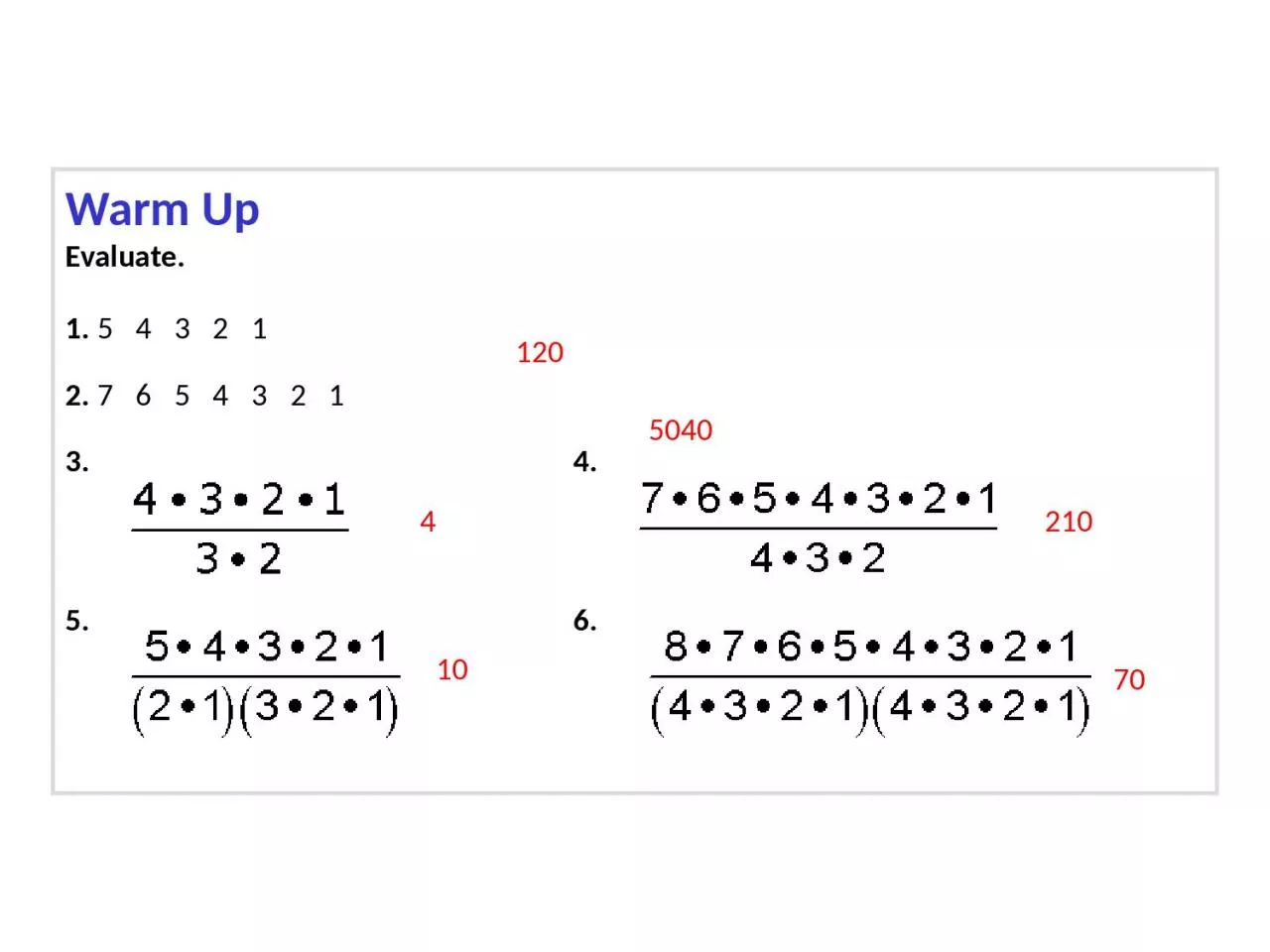

4 3 2 1 2 7 6 5 4 3 2 1 3 4 5 6 120 5040 4 210 10 70 Example 1A Using the Fundamental Counting Principle ID: 1002634
Download Presentation The PPT/PDF document "Warm Up Evaluate. 1. 5" is the property of its rightful owner. Permission is granted to download and print the materials on this web site for personal, non-commercial use only, and to display it on your personal computer provided you do not modify the materials and that you retain all copyright notices contained in the materials. By downloading content from our website, you accept the terms of this agreement.
1. Warm UpEvaluate.1. 5 4 3 2 12. 7 6 5 4 3 2 13. 4.5. 6. 120504042101070
2.
3. Example 1A: Using the Fundamental Counting PrincipleTo make a yogurt parfait, you choose one flavor of yogurt, one fruit topping, and one nut topping. How many parfait choices are there?Yogurt Parfait (choose 1 of each)FlavorPlainVanillaFruitPeachesStrawberriesBananasRaspberriesBlueberriesNutsAlmondsPeanutsWalnuts
4. Example 1A Continuednumberof flavorstimesnumberof fruitsnumberof nutstimesequalsnumberof choices2 5 3 = 30There are 30 parfait choices.
5. Example 1b A password is 4 letters followed by 1 digit. Uppercase letters (A) and lowercase letters (a) may be used and are considered different. How many passwords are possible?Since both upper and lower case letters can be used, there are 52 possible letter choices.letter letter letter letter number52 52 52 52 10 = 73,116,160There are 73,116,160 possible passwords.
6. Example 2: Paint ColorsA paint manufacturer wishes to manufacture several different paints. The categories includeColor: red, blue, white, black, green, brown, yellowType: latex, oilTexture: flat, semi gloss, high glossUse: outdoor, indoorHow many different kinds of paint can be made if you can select one color, one type, one texture, and one use?6Bluman, Chapter 4
7.
8. A permutation is a selection of a group of objects in which order is important.
9. Example 3A: Finding PermutationsHow many ways can a student government select a president, vice president, secretary, and treasurer from a group of 6 people?This is the equivalent of selecting and arranging 4 items from 6.= 6 • 5 • 4 • 3 = 360Divide out common factors.There are 360 ways to select the 4 people.Substitute 6 for n and 4 for r in
10. Example 3B: Finding PermutationsHow many ways can a stylist arrange 5 of 8 vases from left to right in a store display?Divide out common factors. = 8 • 7 • 6 • 5 • 4= 6720There are 6720 ways that the vases can be arranged.
11. Example 4: Business LocationsSuppose a business owner has a choice of 5 locations in which to establish her business. She decides to rank each location according to certain criteria, such as price of the store and parking facilities. How many different ways can she rank the 5 locations?11Bluman, Chapter 4Using factorials, 5! = 120.Using permutations, 5P5 = 120.
12. Example 5: Television News StoriesA television news director wishes to use 3 news stories on an evening show. One story will be the lead story, one will be the second story, and the last will be a closing story. If the director has a total of 8 stories to choose from, how many possible ways can the program be set up?Since there is a lead, second, and closing story, we know that order matters. We will use permutations.12Bluman, Chapter 4
13. A combination is a grouping of items in which order does not matter. There are generally fewer ways to select items when order does not matter.
14. When deciding whether to use permutations or combinations, first decide whether order is important. Use a permutation if order matters and a combination if order does not matter.
15. Example 6: ApplicationThere are 12 different-colored cubes in a bag. How many ways can Randall draw a set of 4 cubes from the bag?Step 1 Determine whether the problem represents a permutation of combination.The order does not matter. The cubes may be drawn in any order. It is a combination.
16. Example 6 Continued= 495Divide outcommonfactors.There are 495 ways to draw 4 cubes from 12.5Step 2 Use the formula for combinations.n = 12 and r = 4
17. Example 7: Newspaper EditingA newspaper editor has received 8 books to review. He decides that he can use 3 reviews in his newspaper. How many different ways can these 3 reviews be selected?The placement in the newspaper is not mentioned, so order does not matter. We will use combinations.17Bluman, Chapter 4
18. Example 8: Combination LocksA combination lock consists of the 26 letters of the alphabet. If a 3-letter combination is needed, find the probability that the combination will consist of the letters ABC in that order. The same letter can be used more than once. (Note: A combination lock is really apermutation lock.)There are 26·26·26 = 17,576 possible combinations.The letters ABC in order create one combination.18Bluman, Chapter 4
19. Example 9: Committee SelectionA store has 6 TV Graphic magazines and 8 Newstime magazines on the counter. If two customers purchased a magazine, find the probability that one of each magazine was purchased.TV Graphic: One magazine of the 6 magazinesNewstime: One magazine of the 8 magazinesTotal: Two magazines of the 14 magazines19Bluman, Chapter 4
20. HomeworkPg. 220 # 7, 11, 13, 27, 33, 35